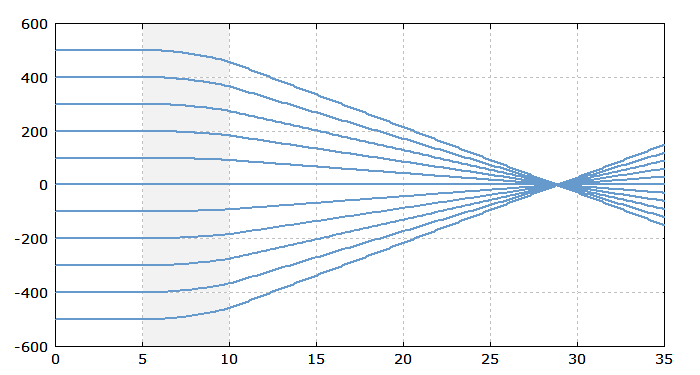Gradient-index Lenses
Acronym: GRIN lens
Definition: lenses which utilize a radial variation of refractive index
More general term: lenses
German: Gradientenindexlinsen
How to cite the article; suggest additional literature
Author: Dr. Rüdiger Paschotta
The essential function of a lens is to produce a radially varying delay of the optical phase of a beam; the resulting wavefront curvature can make a beam converging or diverging after the lens. In ordinary lenses, the radially varying phase delay is produced by varying the thickness of the lens material. An alternative operation principle is that of a gradient index lens (GRIN lens), where the thickness is usually constant, while the refractive index varies in the radial direction. It is also possible (but not common) to combine both operation principles, i.e., to make GRIN lenses with curved surfaces.
Typical GRIN lenses have a cylindrical rod shape, although a wide range of other shapes is possible.
As an example, Figure 1 shows the propagation of rays (according to geometrical optics) which get deflected in a GRIN lens and may exactly meet in a focal point if the lens is optimized.

Figure 2 shows how the beam radius, calculated with wave optics, evolves.

Calculation of Dioptric Power
At least in cases where the paraxial approximation is valid, it is simple to calculate the dioptric power and focal length of a not too long gradient-index lens from its refractive index profile. The calculation is based on the fact that the radially varying phase delay caused by a lens with focal length f is given by the following equation:
One simply needs to equate the second-order coefficients of the index profile to obtain the focal length and its inverse, the dioptric power.
Fabrication of Gradient-index Lenses
There is a range of quite different optical fabrication methods for GRIN lenses; some examples:
- Ion exchange methods: If a glass material is immersed into a liquid, some ions of the glass may be exchanged with other ions in the liquid, such that the refractive index is modified. Applying such a technique to the mantle of a cylindrical glass part can lead to the required refractive index profile.
- Partial polymerization: A polymer material may be exposed to radially varying doses of ultraviolet light which causes polymerization.
- Direct laser writing: The refractive index of various transparent media can also be changed with point-by-point laser writing, where the exposure dose is varied in the radial direction.
- Chemical vapor deposition: Glass materials can be deposited from a chemical vapor, where the chemical composition is varied during the process such that the required index gradient is obtained.
- Neutron irradiation can be used to generate spatially varying refractive index modifications in certain boron-rich glasses.
Applications of GRIN Lenses
GRIN lenses can be used for a wide range of applications – for example:
- fiber collimators, where a GRIN lens may be fused to a fiber end
- fiber-to-fiber coupling
- mode field adapters
- focusing applications, e.g. optical data storage
- monolithic solid-state lasers
- ophthalmology, e.g. for contact lenses with high dioptric power
Typical advantages of GRIN lenses are that they can be very small and that their flat surfaces allow simple mounting together with other optical components. In some cases, flat surfaces are cemented together in order to obtain a rugged monolithic setup.
If the used fabrication method allows for precise control of the radial index variation, the performance of a GRIN lens may be high, with only weak spherical aberrations similar to those of aspheric lenses.
Besides, some fabrication techniques allow for cheap mass production.
Other Devices with an Index Gradient
A radial gradient of the refractive index also often occurs in a laser crystal or other laser gain medium as a result of thermal effects. This phenomenon is called thermal lensing.
There are graded-index fibers, which in contrast to step-index fibers have a smooth variation of refractive index in the radial direction.
Questions and Comments from Users
Here you can submit questions and comments. As far as they get accepted by the author, they will appear above this paragraph together with the author’s answer. The author will decide on acceptance based on certain criteria. Essentially, the issue must be of sufficiently broad interest.
Please do not enter personal data here; we would otherwise delete it soon. (See also our privacy declaration.) If you wish to receive personal feedback or consultancy from the author, please contact him e.g. via e-mail.
By submitting the information, you give your consent to the potential publication of your inputs on our website according to our rules. (If you later retract your consent, we will delete those inputs.) As your inputs are first reviewed by the author, they may be published with some delay.
See also: lenses, microlenses, focal length, thermal lensing, graded-index fibers
and other articles in the category general optics
 |






2020-07-09
Where is the principal plane of a GRIN lens located?
Answer from the author:
The principal plane is usually in the middle, if the index profile has no z dependence. Otherwise, you can have two different principal planes, to be calculated from the design details.